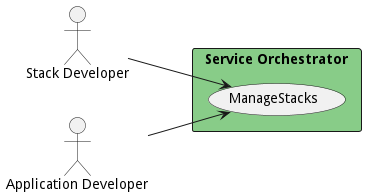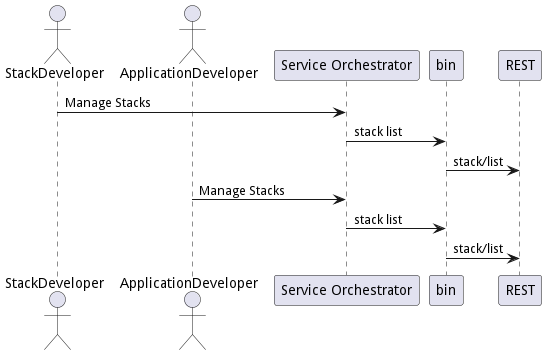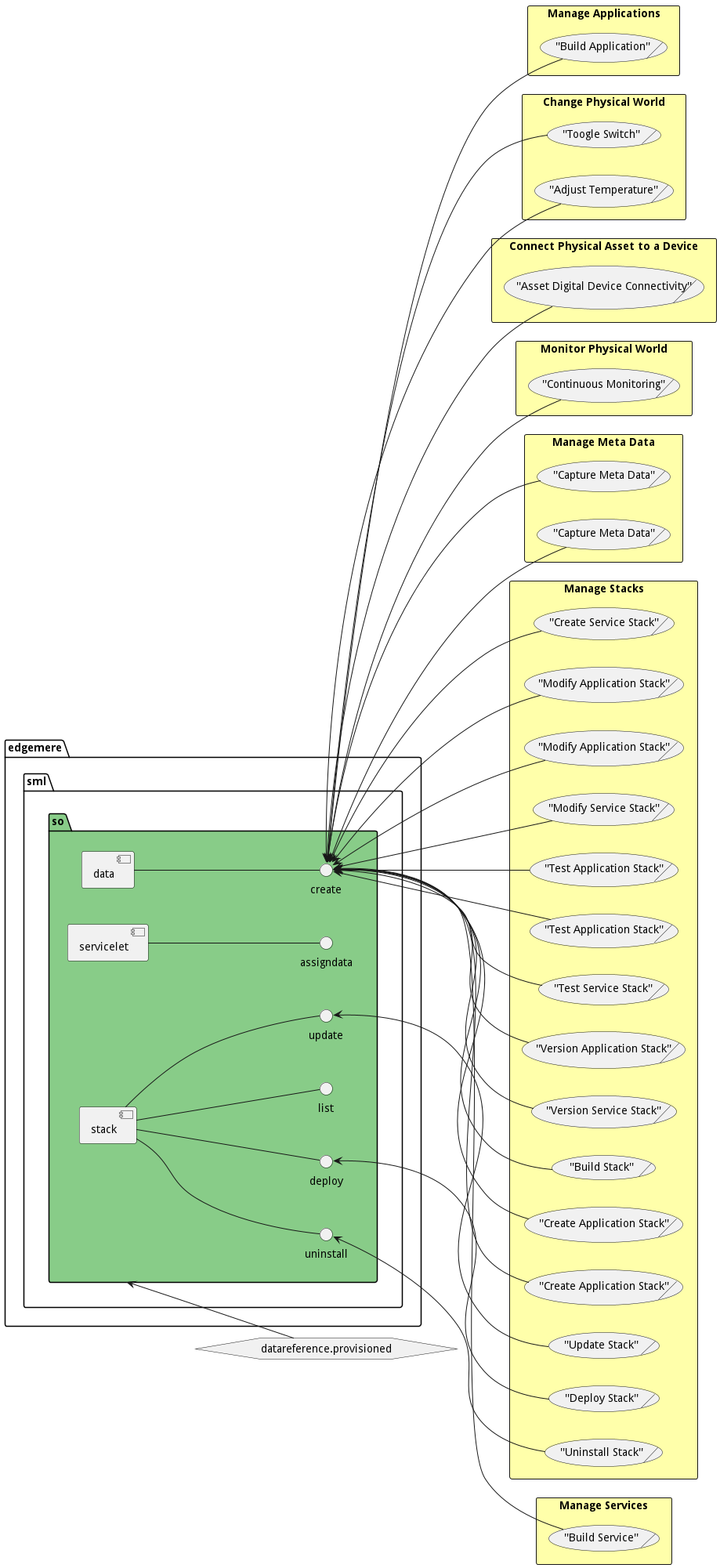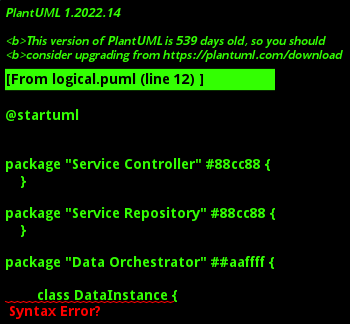Service Orchestrator
Service Orchestrator builds landscape requests for the service or stack. The Landscape Request is generated from the service and stack deployments and coordinates with the Infrastructure Orchestrator Data Orchestrator, and the Application Orchestrator.
Use Cases
The following are the use cases of the Service Orchestrator subsystem. Each use case has primary and secondary scenarios that are elaborated in the use case descriptions.

Users
The following are the actors of the Service Orchestrator subsystem. This can include people, other subsystems inside the solution and even external subsystems.

Interface
The subsystem has a REST, CLI, WebSocket, and Web interface. Use Cases and Scenarios can use any or all of the interfaces to perform the work that needs to be completed. The following diagram shows how users interact with the system.

- edgemere sml so data create
- edgemere sml so servicelet assigndata
- edgemere sml so stack deploy
- edgemere sml so stack list
- edgemere sml so stack uninstall
- edgemere sml so stack update
Logical Artifacts
The Data Model for the Service Orchestrator subsystem shows how the different objects and classes of object interact and their structure.

Sub Packages
The Service Orchestrator subsystem has sub packages as well. These subsystems are logical components to better organize the architecture and make it easier to analyze, understand, design, and implement.

Classes
The following are the classes in the data model of the Service Orchestrator subsystem.
Deployment Architecture
This subsystem is deployed using micro-services as shown in the diagram below. The ‘micro’ module is used to implement the micro-services in the system. The subsystem also has an CLI, REST and Web Interface exposed through a nodejs application. The nodejs application will interface with the micro-services and can monitor and drive work-flows through the mesh of micro-services. The deployment of the subsystem is dependent on the environment it is deployed. This subsystem has the following environments:
Physical Architecture
The Service Orchestrator subsystem is physically laid out on a hybrid cloud infrastructure. Each microservice belongs to a secure micro-segmented network. All of the micro-services communicate to each other and the main app through a REST interface. A Command Line Interface (CLI), REST or Web User interface for the app is how other subsystems or actors interact. Requests are forwarded to micro-services through the REST interface of each micro-service. The subsystem has the a unique layout based on the environment the physical space. The following are the environments for this subsystems.
Micro-Services
These are the micro-services for the subsystem. The combination of the micro-services help implement the subsystem’s logic.
dev
Detail information for the dev environment can be found here
Services in the dev environment
- web : sml_so_web
test
Detail information for the test environment can be found here
Services in the test environment
- web : sml_so_web
prod
Detail information for the prod environment can be found here
Services in the prod environment
- web : sml_so_web
Activities and Flows
The Service Orchestrator subsystem provides the following activities and flows that help satisfy the use cases and scenarios of the subsystem.
Messages Handled
The Service Orchestrator subsystem is an event driven architecture and handle several events. The following events are handled by this subsystem. Please note that this subsystem is not the only subsystem that handles these events.
| Message | Action | Description |
|---|---|---|
| datareference.provisioned | /sml/so/servicelet/assignData |
Messages Sent
| Event | Description | Emitter |
|---|---|---|
| serviceinstance.create | When an object of type ServiceInstance is created. | ServiceInstance |
| serviceinstance.destroy | When an object of type ServiceInstance is destroyed. | ServiceInstance |
| serviceinstance.updated | When an object of type ServiceInstance has an attribute or association updated. | ServiceInstance |
| stackinstance.create | When an object of type StackInstance is created. | StackInstance |
| stackinstance.destroy | When an object of type StackInstance is destroyed. | StackInstance |
| stackinstance.updated | When an object of type StackInstance has an attribute or association updated. | StackInstance |
Interface Details
The Service Orchestrator subsystem has a well defined interface. This interface can be accessed using a command line interface (CLI), REST interface, and Web user interface. This interface is how all other subsystems and actors can access the system.
Action edgemere sml so data create
- REST - /edgemere/sml/so/data/create?attr1=string
- bin - edgemere sml so data create –attr1 string
- js - .edgemere.sml.so.data.create({ attr1:string })
Description
Description of the action
Parameters
| Name | Type | Required | Description |
|---|---|---|---|
| attr1 | string | false | Description for the parameter |
Action edgemere sml so servicelet assigndata
- REST - /edgemere/sml/so/servicelet/assigndata?servicelet=ref&dataReference=ref
- bin - edgemere sml so servicelet assigndata –servicelet ref –dataReference ref
- js - .edgemere.sml.so.servicelet.assigndata({ servicelet:ref,dataReference:ref })
Description
Assign Data Instances from the Data Reference
Parameters
| Name | Type | Required | Description |
|---|---|---|---|
| servicelet | ref | true | ServiceInstance to connect the Data Reference Instance |
| dataReference | ref | true | Data Reference to get the instances |
Action edgemere sml so stack deploy
- REST - /edgemere/sml/so/stack/deploy?name=string&tag=string&env=string&args=json
- bin - edgemere sml so stack deploy –name string –tag string –env string –args json
- js - .edgemere.sml.so.stack.deploy({ name:string,tag:string,env:string,args:json })
Description
Description of the action
Parameters
| Name | Type | Required | Description |
|---|---|---|---|
| name | string | false | Name of the stack to deploy |
| tag | string | false | Tag of the deployment of the stack. This is used to reference the deployed stack. |
| env | string | false | Name of the deployment environment |
| args | json | false | Arguments passed into the stack deployment |
Action edgemere sml so stack list
- REST - /edgemere/sml/so/stack/list?attr1=string
- bin - edgemere sml so stack list –attr1 string
- js - .edgemere.sml.so.stack.list({ attr1:string })
Description
Description of the action
Parameters
| Name | Type | Required | Description |
|---|---|---|---|
| attr1 | string | false | Description for the parameter |
Action edgemere sml so stack uninstall
- REST - /edgemere/sml/so/stack/uninstall?attr1=string
- bin - edgemere sml so stack uninstall –attr1 string
- js - .edgemere.sml.so.stack.uninstall({ attr1:string })
Description
Description of the action
Parameters
| Name | Type | Required | Description |
|---|---|---|---|
| attr1 | string | false | Description for the parameter |
Action edgemere sml so stack update
- REST - /edgemere/sml/so/stack/update?attr1=string
- bin - edgemere sml so stack update –attr1 string
- js - .edgemere.sml.so.stack.update({ attr1:string })
Description
Description of the action
Parameters
| Name | Type | Required | Description |
|---|---|---|---|
| attr1 | string | false | Description for the parameter |